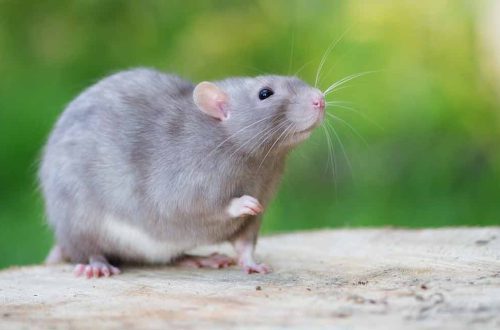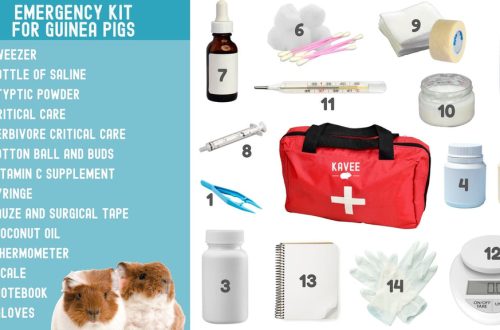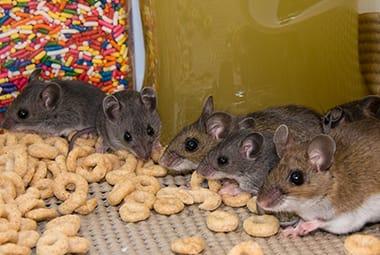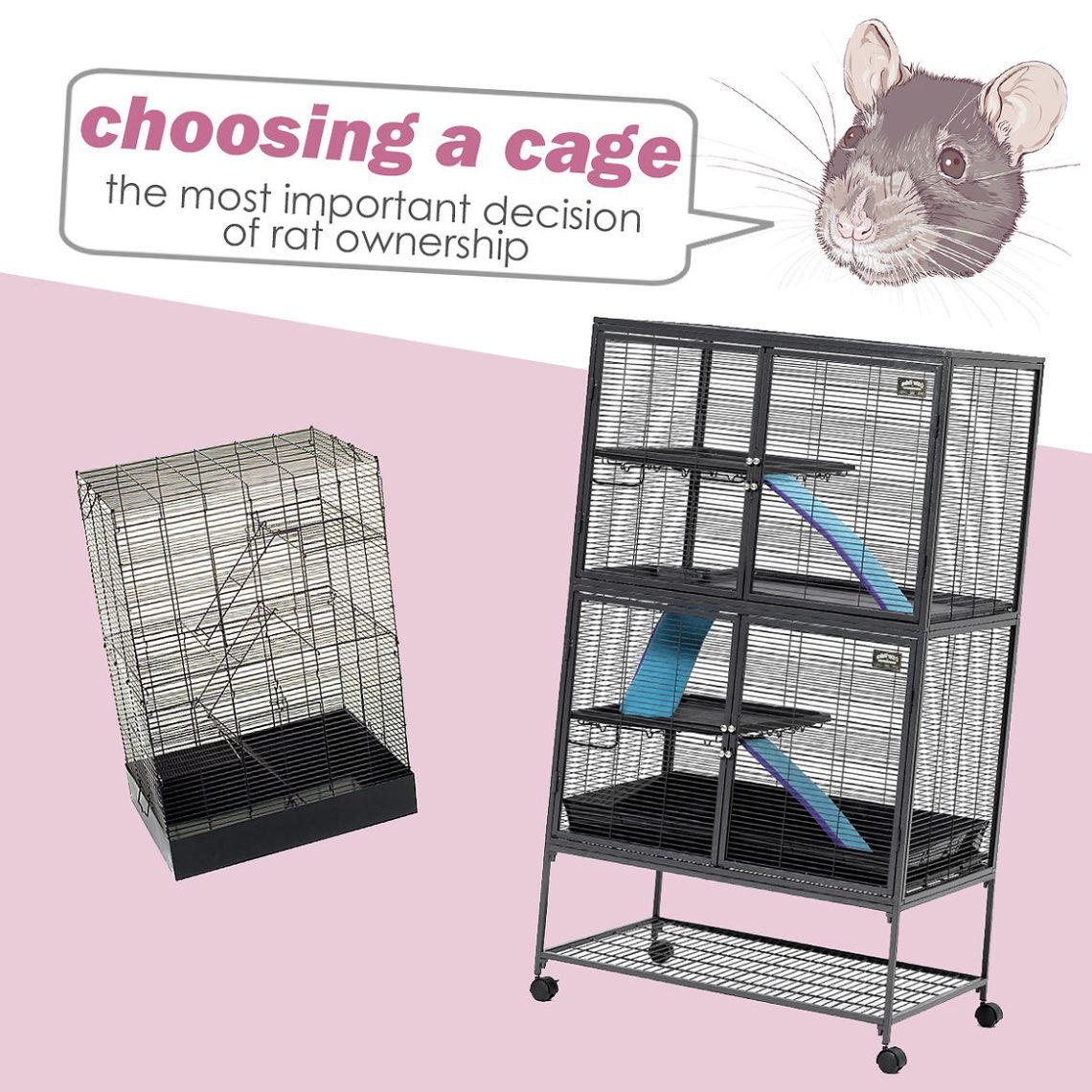
Cage no nā ʻiole: nā lula no ke koho ʻana a me ka hoʻonohonoho ʻana (kiʻi)
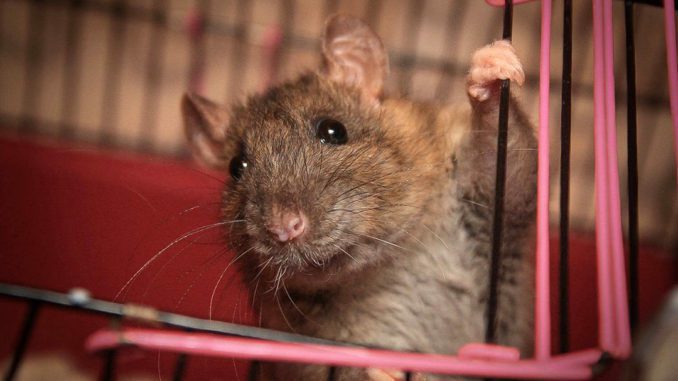
The first question that arises when deciding to get a decorative rat is where to place a new pet. The rat cage is the main element that provides comfortable and safe conditions for the life of the animal. Many owners let their pets roam freely around the room, but even in this case, you need a place that the animal will consider a personal territory where it will feel calm. The lattice walls will also become additional protection if the apartment contains other animals – a dog or a cat. An important factor is the ease of cleaning – in the absence of a cage, the room will inevitably suffer from pollution.
Contents
Features of the cage for domestic rats
When choosing, it is important to remember that containers with smooth walls – glass or plastic, as in a terrarium, are not suitable for any rodents. In such devices, the air stagnates and becomes too humid, and the bedding is always damp, which leads to the rapid growth of bacteria. Content in such a cage can weaken the animal and cause the development of a number of diseases.
For ornamental rats, only cages with lattice walls that allow air to pass freely are suitable.
The distance between the rods should not exceed 0,7-1 cm for young rats, and 1,2-1,5 cm for adults. Otherwise, the rat may hurt itself by trying to stick its muzzle into the slot.
The metal of the rods must be reliably protected from corrosion, most often enamel paint or galvanization is used. Check the quality of the coating before buying – properly applied paint will not peel off. The sharp ends of the rods must be firmly welded and processed so that the animal does not catch on or get hurt. Collapsible and folding structures would be preferable – such a cage is easier to transport, and if you have to put it away for storage, it will not take up much space.
It is better to choose a pallet high enough, at least 10 cm. Then the filler will not scatter during active games of animals.
It is not recommended to choose wooden or metal pallets – they are subject to the negative effects of moisture and will not last long. Metal rusts, wood absorbs odor, and is also successfully gnawed by rats.
The best choice is a plastic tray made of durable plastic that is easy to clean. When choosing, pay attention to the quality – there should not be a sharp chemical smell, stains, chips or cracks.
What should be the cell size
The size of the device depends on several factors, the most significant of which is the number of animals. If you are going to accommodate only one or two animals, a pallet size of 60×40 cm will suffice. If there are several animals, a large cage will be required.
The gender of the animals is also important – for keeping boys it is recommended to choose a horizontal model with a wide pallet, and for girls it is better to take a higher cage, as they are lighter and more mobile, and love to climb. It will be enough to have a cage 60 cm high with several tiers.
To calculate how big a rat cage should be, you can use a formula. Multiply together the length, width and height in centimeters, then divide by 100000 to get the number of adults that can be housed in a cage.
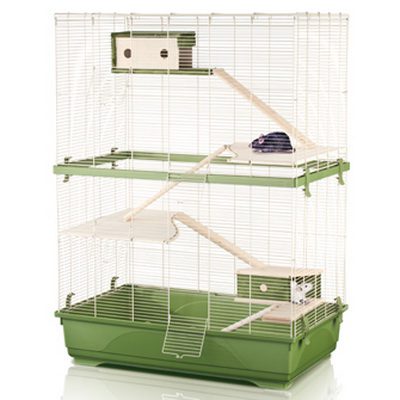 | 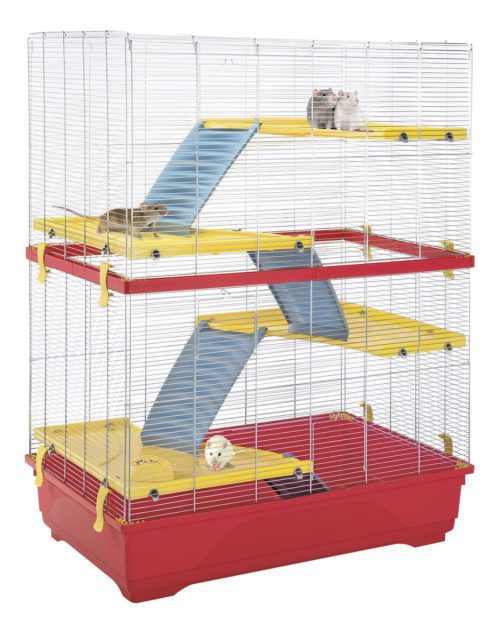 |
The choice of size of course depends on the specific conditions in the apartment. If you do not have the opportunity to put a large cage, you should think about postponing the purchase of an animal.
A small cage will quickly become small for a growing rat, and if there is not enough space, it will begin to suffer from a sedentary lifestyle and associated diseases. A small cage can also negatively affect the character of the animal, making it restless and aggressive.
How much does a rat cage cost
In many ways, the choice of a rat cage depends on the amount you are willing to spend. The modern pet industry offers a huge number of options – from the simplest models to impressive designs with a full set of internal equipment. The cost is affected by both the size of the cage and the quality of the materials of manufacture.
Cheap cages – such models are suitable if you are unpretentious in design, want to avoid high costs and will be able to assemble everything you need for your pet yourself. Inexpensive devices are usually non-separable, have a simple appearance, a minimum number of shelves and ladders, they do not have a drinker and toys. Despite this, it is quite possible to choose a large and comfortable cage where the animal will feel good. Simple shaped devices are also easier to clean. If you want to place several cages in a room, it will be easy to stack them on top of each other.
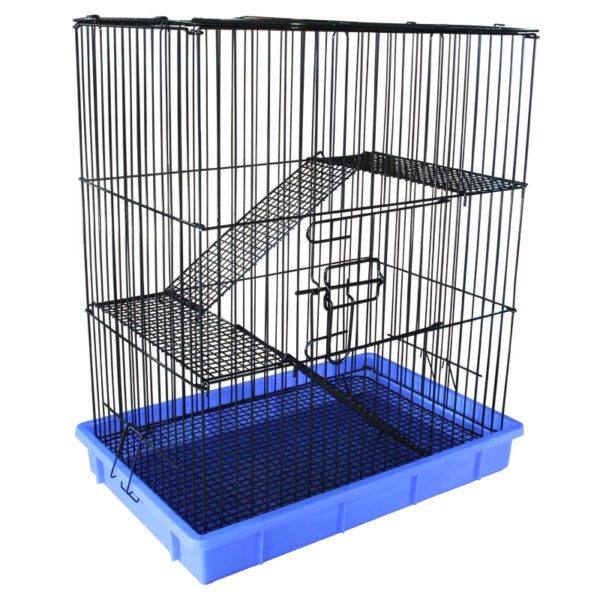 | 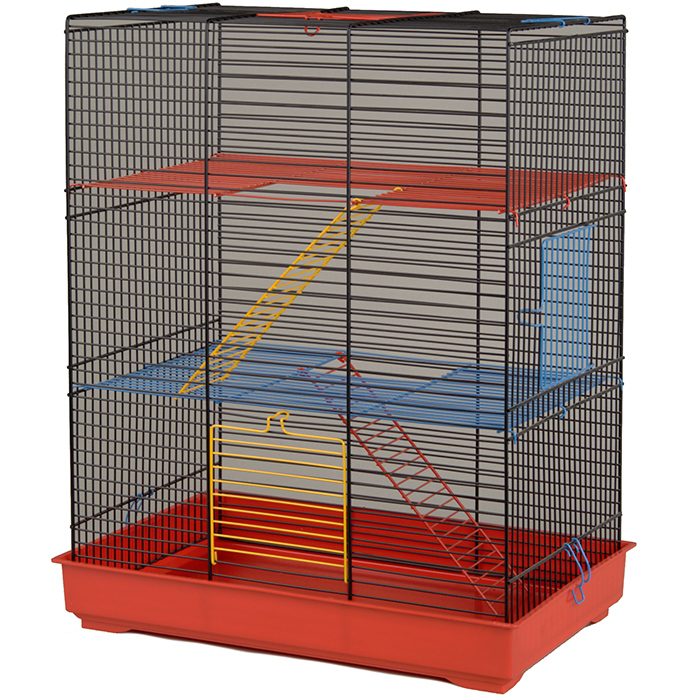 |
Dear cells – the range of such devices is very wide. You will find cages of various shapes and designs, made in various styles, decorated with bright colored plastic shelves, full of interesting toys and useful additions. Usually you do not need to collect accessories for such a cage – everything is already included. This can be a good choice if you are a new owner and don’t yet know exactly how to create a comfortable environment for the animal. Such cells will also be a wonderful showy gift.
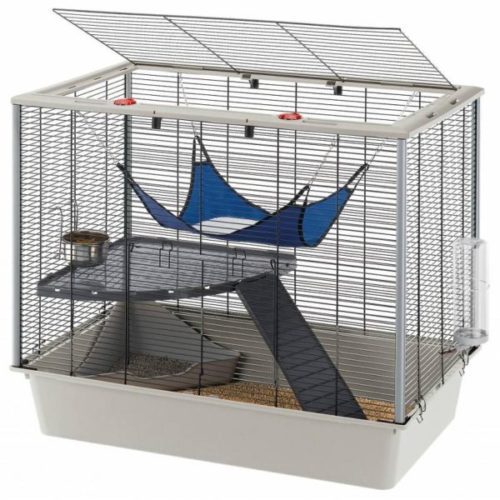 | 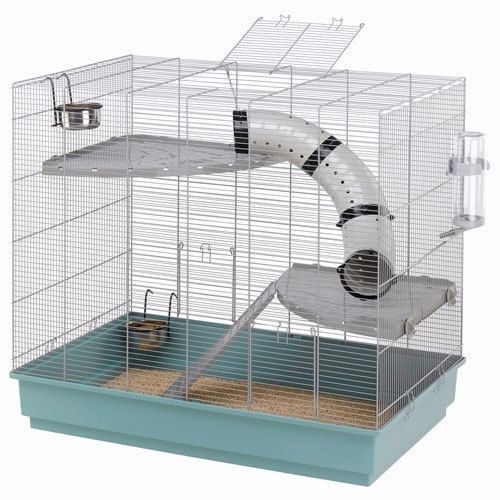 |
How to furnish a rat cage
The conditions in which an animal is kept have a great influence on its character, behavior and health. Therefore, arranging a cage for rats is the most important task that must be approached with responsibility. The first step is to take care of the filler – clean wood shavings, pressed corn filler, paper (you can’t use newspapers because of printing ink) work well.
We list what should be in a rat’s cage without fail:
- Drinking bowl – it is better to choose a ball, with a metal spout. Such a model is attached to the back of the wall, and the spout is conveniently pushed inward through the grate.
- Food Bowls – Rats love to flip, drag, and chew on their bowls, so heavier ceramic or hanging metal items are fine for them.
- Hammock – it is recommended to equip a sleeping place in a cage, soft hanging hammocks are very popular with rats.
- A house is a place where animals can hide if they want peace or are frightened. Most rats prefer to sleep outside the house, but it is still better to put it up – this way they will feel more protected.
- Toilet – most often it is a plastic or ceramic container, which is conveniently located in the corner of the pallet.
Shelves are also required for installation on different tiers – the distance between them should be at least 15-20 cm, then an adult rat will be able to stand on its hind legs or jump without the risk of injury. A lattice or plastic plate is fixed on each floor, which often becomes a favorite place to lie and watch what is happening in the room.
Toys and simulators in a cage
Rats are very active, agile animals, so they should be able to climb and jump a lot. The whole cage for them is an additional simulator that allows you to make up for the lack of movement. They willingly climb the walls, jump on the shelves, get out onto the roof and go down the outside of the wall. It is best if the bars on the walls are located horizontally – for easy climbing.
The presence of stairs is optional – the animals are great at climbing walls or jumping from shelf to shelf.
Some owners even remove the stairs themselves to increase the space. But many rats love ladders, using them not only for climbing, but also as a vantage point.
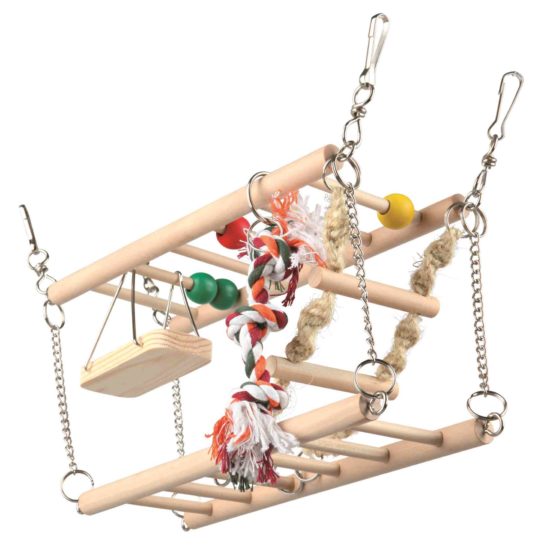
If your pet is still very small, or, on the contrary, elderly, then the ladder makes it easier for him to move around the cage, and also insures against falling.
If you decide to equip a rat cage yourself, you need to make more toys for your pet. This is especially true for animals that are kept alone. The lack of communication should be compensated not only by daily games with the owner, but also by various exciting studies. Then the pet will be constantly busy, will be able to avoid longing and boredom. Suitable for installation in a cage:
- wooden, plastic pieces of pipes – they can serve as transitions or a house;
- metal springs that can be hung between floors instead of stairs;
- cords made of thick rope with a large knot at the end;
- swing – wooden or rope;
- wooden toys for chewing – you can put a treat wrapped in paper into the holes.
A rat in a cage does not need a running wheel – a too long tail will prevent it from running on it.
Popular walking balls are also not suitable for these animals – rats are too curious, they like to inspect everything, sniff. To make up for the lack of movement, it is better to walk the animal under supervision or on a harness.
Proper cage care
The habitat of a domestic rat must be kept clean – this way you will avoid an unpleasant smell and the risk of disease in the animal. It is recommended to do a little cleaning every day – clean the toilet, change some of the sawdust that has become contaminated, wipe the bowls, pour fresh water into the drinker.
At least once a week, a general cleaning of the cage should be carried out – completely replace the filler, thoroughly wash the pallet and shelves, wipe the simulators and toys.
For wet cleaning, it is better not to use products with a pungent odor, and also to ensure that the detergent compositions are completely washed off the surface.
Video: rat cage review
How to choose and equip a cage for a domestic rat
4.3 (86.9%) 168 koho





